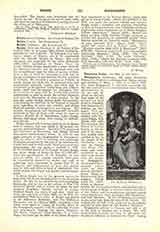

Borgognone, AMBROGIO, real name AMBROGIO STEFANI DA FOSSANO, a distinguished Italian painter and architect, b. Milan, c. 1455; d. at Milan, 1523. The name Borgognone is variously accounted for. By some authorities it is attributed to some Flemish characteristics in his art, and by others to the fact that some of his ancestors had lived in Flanders, then known to the Italians as Borgogna. It is supposed that he studied with Vincenzo Foppa, with Zenale, and with Buttinone, but there is little known of the details of his career. The earliest work credited to him is the facade of the Carthusian convent or Certosa near Pavia. The stalls and other woodwork in the choir were carved from the designs of Borgognone, who painted there, among other works, an altar piece of the Crucifixion. Great refinement and deep religious feeling mark his work, which is likewise notable for its beautiful celestial and mundane types. On his return to Milan he went to work in the church of San Satiro, and his productions appeared, among other churches, at Sant’ Ambrogio, San Simpliciano, and Sant’ Agostino. At San Simpliciano he painted scenes, since lost, from the story of St. Sisinius. He worked also at Lodi in the church of the Incoronata and did an altar piece for San Satiro at Bergamo.
Borgognone painted in tempera and also in oil in the style of tempera and in fresco. His early work lacked freedom, but later he fell under the beneficent influence of Leonardo da Vinci. Among his works in public galleries are: National Gallery, London, “Marriage of St. Catherine of Alexandria“; a triptych with a “Virgin and Child Enthroned”, having at one side the “Agony in the Garden”, and on the other “Christ Bearing His Cross”, and two groups of family portraits; Louvre, “Presentation in the Temple“, and “St. Peter of Verona”, with a kneeling woman; Berlin Museum, “Madonna Enthroned”, and “Madonna with Saints”; Munich, Old Pinakotek, “Madonna in Adoration“; Dresden Gallery, “Madonna in Adoration“; Brera Gallery, Milan, “The Assumption of the Virgin”; and Pavia Academy, “Christ Bearing His Cross, followed by Carthusian”. In the Casa Borromeo at Milan is a portrait of Bishop Andrea Novelli. The Pavia picture is considered without an equal in art in simple pathos and deep religious meaning. Lanzi and other authors have treated Ambrogio da Fossano, the architect, and Ambrogio Borgognone, the painter, as two different persons, but the signatures he left show that this was not the case.
AUGUSTUS VAN CLEEF

